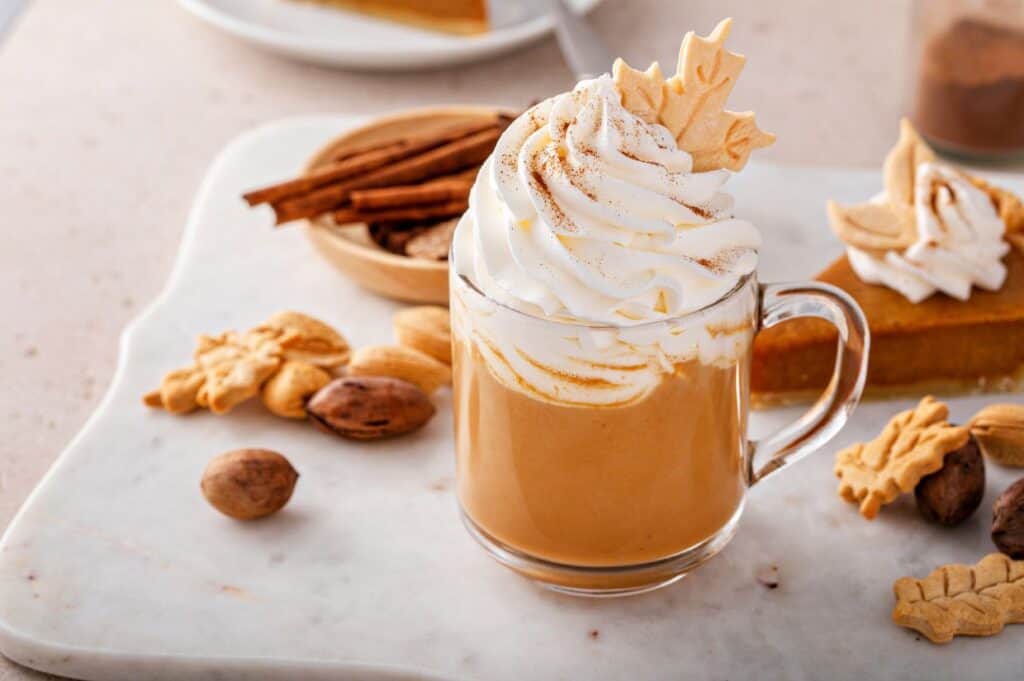It’s not really fall until you have a warm cup of pumpkin spice latte in your hands. This iconic flavor, which has become synonymous with the leaves changing, has raked in millions of dollars and created an empire. Find out how pumpkin spice has become a cultural phenomenon, from its nostalgic appeal to its exclusivity that has solidified its position as a fall sensation.

Recreating the success of peppermint mocha
The origin of Starbucks’ iconic pumpkin spice latte, or PSL, comes from the brand’s attempt to replicate the success they had with their first seasonal beverage, peppermint mocha. After finding a hit drink for winter, the coffee giant aimed to create one for autumn as well. The development process began, and after considering hundreds of ideas, the pumpkin flavor emerged as one of the most unique options. Following months of recipe refinement and market tests, it became evident that the PSL would be a hit. The birth of this iconic drink and multi-billion empire was a result of Starbucks recognizing that seasonal drinks work for multiple reasons, including their ability to evoke nostalgia.
The unforgettable nature of sensory marketing
Pumpkin spice has an iconic scent that evokes nostalgia and cozy feelings reminiscent of fall. Its blend of cinnamon, nutmeg, cloves and ginger immediately triggers happy memories associated with this season, such as watching the leaves change colors, eating pumpkin bars at family gatherings and visiting pumpkin patches.
Starbucks has leveraged this smell to create a strong emotional connection between its customers and the product — after all, nostalgia is irresistible. You’ll probably hear that it’s not fall until Starbucks releases its pumpkin spice latte, making it the drink of the season that marks the end of summer and the start of fall festivities.
Limited edition creates FOMO
The pumpkin spice latte is only available during the fall, which is a crucial part of its success in Starbucks’ drink portfolio. The exclusivity of this flavor builds excitement around its release every year, making consumers more inclined to make a purchase. Consumers also perceive its limited availability as a special treat instead of a regular product, encouraging them to indulge and be willing to purchase it for premium prices.
The same goes for other autumn-related products, like a pumpkin s’mores cookie cake, which you can’t find at any other time of the year. With limited supply comes higher demand and the ability for companies to earn higher profits on their pumpkin spice products. That is why Starbucks is projected to make around $500 million on this drink alone this upcoming season, according to MarketWatch.
Social media amplifies the craze
Posts about pumpkin spice flood social media platforms every fall. Customers love to snap a picture of the aesthetic pumpkin spice drink and share their love for it online. This free publicity generates a lot of buzz around the flavor, enticing new and returning customers to purchase another cup.
There is no doubt that social media has played a big role in the popularity of pumpkin spice. Starbucks, for example, even considered taking it off the menu in the early 2000s, a few years after its development, to keep the menu fun and fresh. However, once Facebook and Twitter came along in 2006, it changed the game entirely, launching PSL into stardom. Nowadays, short-form video content on TikTok and Instagram Reels has become the new trend, and Starbucks uses these platforms to tease the rerelease of the drink at the end of every August.
Pumpkin spice goes beyond drinks
After brands noticed the pumpkin spice craze, they quickly expanded into other categories. It’s not just drinks anymore; there are spiced pumpkin pies, candles, beauty products and decor. The expansion into different industries is proof of this flavor’s influence and how it created a multi-billion-dollar market.
The diversification goes beyond your wildest dreams. In addition to cookies, pumpkin spice cake, popcorn, almonds and even cup noodles can be found. For those who want to infuse their home with this scent, there are pumpkin spice air fresheners and cleaning products available. You can even complete your morning routine with a pumpkin spice-inspired makeup palette and lip gloss. The infiltration of this flavor beyond drinks has allowed it to reign over this season.
Understanding what the consumers want
For a trend to remain relevant and not become a passing fad, brands have to evolve their offerings and adapt to changing preferences. There is a growing awareness of health among consumers, with 50% of Americans stating that they actively strive to eat healthily, according to a 2023 Statista Consumer Insights survey. To keep up with the demand for healthier products, plant-based and low-sugar options for pumpkin spice products have been released so consumers can satisfy their fall cravings without guilt.
It’s more than just a flavor
The multi-billion-dollar success of pumpkin spice flavor is not solely due to its delicious taste; it’s also about the cozy, nostalgic feelings it evokes and its exclusivity, being available only a few weeks a year. Pumpkin spice has garnered a loyal fanbase because brands have unlocked the secret sauce — it’s not just about selling a drink, candle or cookie, but about offering an authentic fall experience.
Mandy Applegate is the creator behind Splash of Taste and four other high-profile food blogs. She’s also a co-founder of Food Drink Life Inc., the unique and highly rewarding collaborative blogger project. Her articles appear frequently on major online news sites and she always has her eyes open to spot the next big trend.